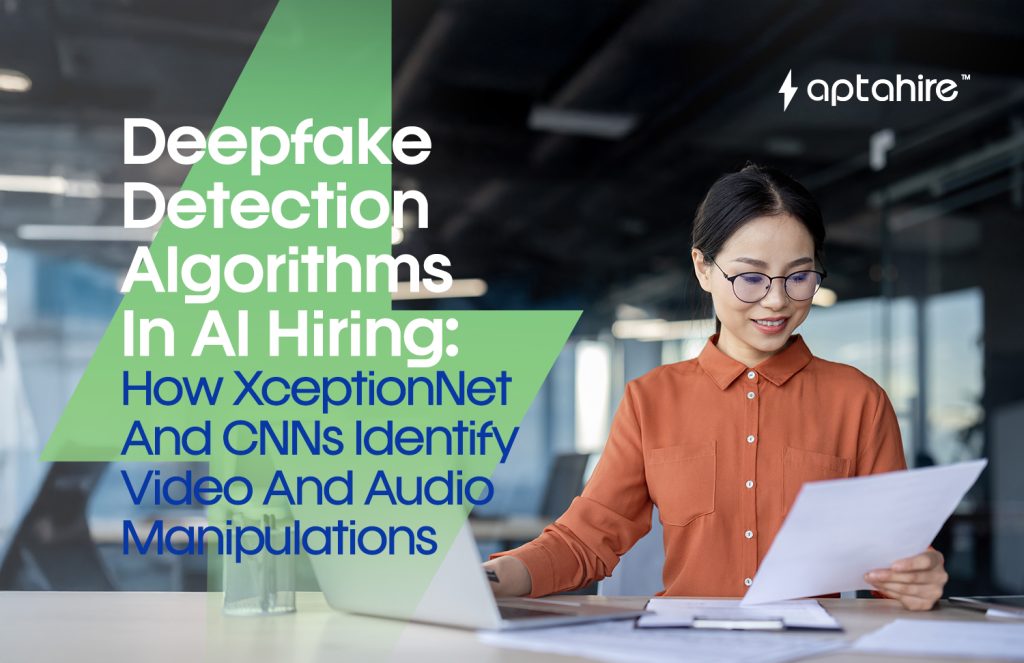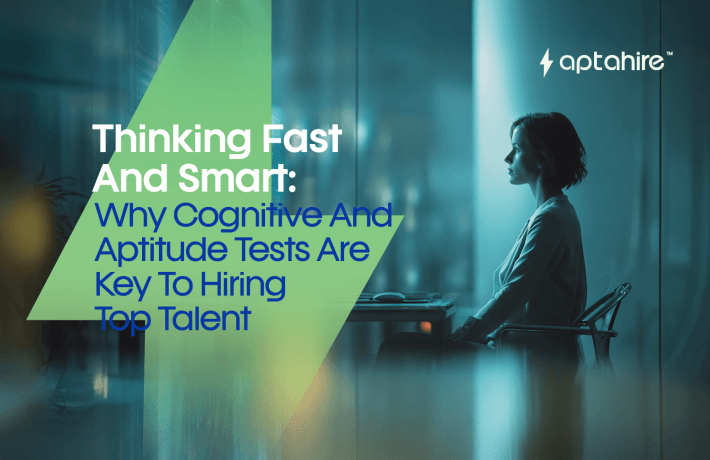Deepfake Detection Algorithms in AI Hiring: How XceptionNet and CNNs Identify Video and Audio Manipulations

Introduction: The Rising Tide of Deepfakes in Hiring
In an era where AI is revolutionizing the hiring process: bringing speed, efficiency, and objectivity, another form of AI has emerged from the shadows to challenge its integrity: deepfakes.
Deepfakes use AI to manipulate video and audio content, making it appear as though someone said or did something they didn’t. From face-swapping in videos to mimicking voices, deepfakes have made their way into places we least expect, including virtual job interviews.
As remote hiring continues to rise, so do the risks of manipulated identities. That’s why AI hiring tools are evolving, integrating powerful detection algorithms such as XceptionNet and Convolutional Neural Networks (CNNs) to spot these digital deceptions in real-time.
This blog takes a deep dive into how these algorithms work, why they matter in hiring, and how they’re safeguarding the future of recruitment.
What Are Deepfakes and Why Are They a Threat in Hiring?
Deepfakes are AI-generated media in which someone’s appearance or voice is altered to make them appear as someone else. This manipulation is typically achieved using Generative Adversarial Networks (GANs)—a deep learning model that pits two neural networks against each other (a generator and a discriminator) to create hyper-realistic forgeries.
In the context of hiring, these can take several dangerous forms:
- A candidate using someone else’s face via a video filter during a live interview.
- Manipulated audio to fake voice identity.
- Pre-recorded responses synced with lip movements.
- AI-generated videos of someone “speaking” answers live.
This creates huge challenges for HR teams and AI recruiters: how can you ensure the person you’re evaluating is really who they say they are?
Enter deepfake detection algorithms like XceptionNet and CNNs.
How Deepfake Detection Works in AI Hiring Tools
AI hiring tools integrate deepfake detection mechanisms at various stages of the interview process. Here’s a simplified flow:
- Video and Audio Capture
During a live or pre-recorded interview, the AI captures the candidate’s facial movements, expressions, voice, and background audio.
- Preprocessing
The data is cleaned and standardized. Frames are extracted from the video, facial landmarks are detected, and audio is broken down into spectrograms.
- Detection Using AI Models (XceptionNet, CNNs)
These processed inputs are fed into trained deep learning models to identify signs of manipulation.
- Decision Engine
Based on the detection scores and confidence levels, the system flags the interview as authentic or suspicious.
Let’s break down the two key players in this detection game: XceptionNet and CNNs.
XceptionNet: The Powerhouse of Deepfake Detection
What is XceptionNet?
XceptionNet (Extreme Inception) is an advanced deep neural network architecture based on depthwise separable convolutions. It was originally developed by François Chollet and has become one of the most effective models in computer vision tasks, including face recognition and manipulation detection.
What makes it special for deepfake detection?
- Handles Fine-Grained Patterns: Deepfakes often leave behind subtle inconsistencies, like unnatural eye blinking, jittery face textures, or strange lighting. XceptionNet excels at detecting these fine patterns.
- Works Frame-by-Frame: It analyzes each frame of a video in great detail, identifying anomalies in facial features, skin texture, and even micro-movements.
- Deep Layered Analysis: The deeper the network, the more layers it has to examine abstract features. XceptionNet’s layered structure gives it a significant edge over traditional CNNs.
How Does XceptionNet Detect Deepfakes in Hiring?
- Input: Each frame from the candidate’s video is fed into the model.
- Feature Extraction: XceptionNet processes the facial features using its convolutional layers.
- Prediction: It outputs a confidence score indicating whether the frame is real or fake.
- Aggregated Verdict: Multiple frames are analyzed together to avoid false positives and provide a final authenticity score.
In platforms like Aptahire, this can be used to give recruiters peace of mind that every live interview is conducted by a real person, in real time.
CNNs: The Backbone of Visual Analysis
What are Convolutional Neural Networks (CNNs)?
CNNs are the foundational building blocks of computer vision in AI. These networks are designed to process grid-like data, like images or video frames. CNNs are made up of layers that filter, pool, and flatten images to extract meaningful patterns.
They’re great at recognizing:
- Faces and facial landmarks
- Expressions and emotions
- Motion and continuity
- Lighting inconsistencies
How CNNs Help in Deepfake Detection
- Detecting Visual Artifacts
Deepfakes often leave behind pixel-level artifacts like mismatched shadows, fuzzy edges, or blurred areas, subtleties the human eye might miss, but CNNs won’t.
- Monitoring Temporal Consistency
A human face moves fluidly; deepfake videos might show awkward transitions or frame inconsistencies. CNNs can flag those subtle timing issues.
- Voice-Lip Sync Check
CNNs can be used with audio analysis to ensure that the candidate’s lip movements match the spoken audio, catching dubbed or manipulated videos.
Combining XceptionNet + CNNs = Stronger Detection
While CNNs offer broad detection capabilities, XceptionNet brings in more nuanced, high-precision analysis. When used together:
- CNNs perform an initial scan for obvious red flags.
- XceptionNet dives deeper into suspicious frames for a finer check.
- Combined with audio detection (like using RNNs or WaveNet for audio forensics), the system becomes robust against both video and voice-based deepfakes.
This layered architecture ensures a multi-dimensional safeguard for AI hiring systems.
Real-Life Scenario: Deepfake Attempt in a Virtual Interview
Let’s consider a hypothetical:
A candidate applies for a remote software engineering role with a fake resume and enlists a more qualified friend to attend the video interview on their behalf. They use a deepfake tool to make the video appear as if it’s the actual applicant.
During the interview:
- The AI hiring system picks up lip-sync mismatch between voice and mouth movement.
- Eye blink rate and pupil dilation appear inconsistent.
- Microexpressions like smile asymmetry raise flags.
- Audio spectrogram analysis shows signs of synthetic voice tampering.
The detection algorithm, powered by CNN and XceptionNet, immediately flags the video as manipulated and alerts the recruitment team.
Result? The company avoids hiring a fraudulent candidate. The system acts as a real-time gatekeeper.
Why Companies Should Care About This
1. Protecting Brand Reputation
A deepfake-induced hiring scandal can damage a company’s image and erode trust in its hiring practices.
2. Ensuring Workplace Security
Hiring someone under a false identity poses major security risks, especially in sensitive sectors like finance, healthcare, or IT.
3. Upholding Diversity & Fairness
Deepfakes can bypass DEI (Diversity, Equity, Inclusion) safeguards by faking ethnicity, gender, or disabilities. AI tools ensure identity authenticity to maintain fairness.
4. Compliance with Data Regulations
Using deepfake detection ensures compliance with data protection and identity verification norms across regions.
Limitations & Challenges
Even though XceptionNet and CNNs are powerful, they’re not foolproof:
- Evolving Deepfake Technology: As detection improves, so do deepfake generation methods.
- False Positives/Negatives: There’s always a margin of error.
- High Computational Costs: Real-time analysis of video and audio requires significant processing power.
To overcome this, detection systems are continuously trained on newer datasets (like FaceForensics++, DFDC) to improve accuracy.
Conclusion: AI vs AI – The Battle of Trust
As deepfakes become more sophisticated, the battle for hiring integrity becomes a race between AI for good and AI for deception.
Platforms like Aptahire, HireVue, or Deepsense Digital’s AI hiring tools are embracing deepfake detection with advanced algorithms like XceptionNet and CNNs, ensuring that authenticity, fairness, and trust remain at the core of hiring practices.
In the digital hiring world, it’s not just about finding the best talent, it’s about making sure you’re hiring the right person. And thanks to these detection technologies, you now can.
FAQs
1. What is a deepfake, and why is it a threat in AI-based hiring?
A deepfake is a synthetic video or audio file generated using deep learning techniques to mimic a real person’s appearance or voice. In hiring, deepfakes pose a serious threat by allowing fraudulent candidates to fake their identity during video interviews, leading to mis-hires, security breaches, and data privacy violations.
2. How does XceptionNet help in detecting deepfakes during virtual interviews?
XceptionNet is a deep convolutional neural network architecture designed to detect image anomalies. It’s particularly effective in frame-by-frame analysis of video interviews to identify:
- Inconsistent facial movements
- Lip-sync mismatches
- Compression artifacts
- Texture abnormalities
It classifies whether a video is real or manipulated with high accuracy, making it a robust tool for deepfake detection in AI hiring platforms.
3. What role do CNNs (Convolutional Neural Networks) play in identifying deepfakes?
CNNs are the foundation of most deepfake detection algorithms. In hiring platforms, CNNs are trained on large datasets of authentic and fake interview footage to learn patterns that differentiate real faces from synthetically generated ones. They:
- Analyze facial expressions
- Detect unnatural blinking or gaze
- Identify inconsistencies in lighting and shadows
Their ability to learn visual features makes CNNs essential for automated video authenticity checks.
4. Can deepfake detection tools also identify audio manipulations or voice cloning?
Yes. Advanced models used in platforms like Aptahire combine audio forensics with visual deepfake detection. These tools analyze:
- Voice modulation, pitch consistency, and background noise
- Temporal mismatches between lip movement and spoken words
- Frequency spectrum anomalies common in cloned voices
Together, these audio-visual cues flag manipulated interviews, ensuring that the voice belongs to the actual candidate.
5. How does Aptahire use these algorithms in real-time hiring scenarios?
Aptahire integrates XceptionNet and CNN-based detection models into its live and recorded interview workflows. It performs:
- Real-time facial verification
- Frame-by-frame video analysis
- Deepfake scoring with authenticity flags
If anomalies are found, the candidate is either flagged for review or automatically disqualified, ensuring zero tolerance for impersonation.
6. What kinds of manipulations can these algorithms detect besides deepfakes?
Beyond deepfakes, Aptahire’s detection suite can uncover:
- Pre-recorded video playback
- Use of screen filters or avatars
- Voice changers and synthetic audio tools
- Face overlays or motion-capture disguises
The combination of computer vision, audio analysis, and behavioral tracking enables a full-spectrum approach to fraud detection.
7. Are there any false positives or limitations with deepfake detection in interviews?
While detection models like XceptionNet are highly accurate, they can sometimes flag:
- Low-light conditions
- Poor camera quality
- Lagging or buffering videos as anomalies
That’s why Aptahire uses multi-layer validation, including contextual cues, biometrics, and post-interview verification, to minimize false positives and ensure fair evaluations.
8. How does this technology help in building trust in remote hiring?
By using deepfake detection algorithms, AI hiring platforms:
- Protect against identity fraud
- Maintain interview integrity
- Reinforce candidate authenticity
This builds trust in remote-first or hybrid hiring setups, ensuring companies only invest in genuine, skilled talent while candidates experience a transparent and secure process.



